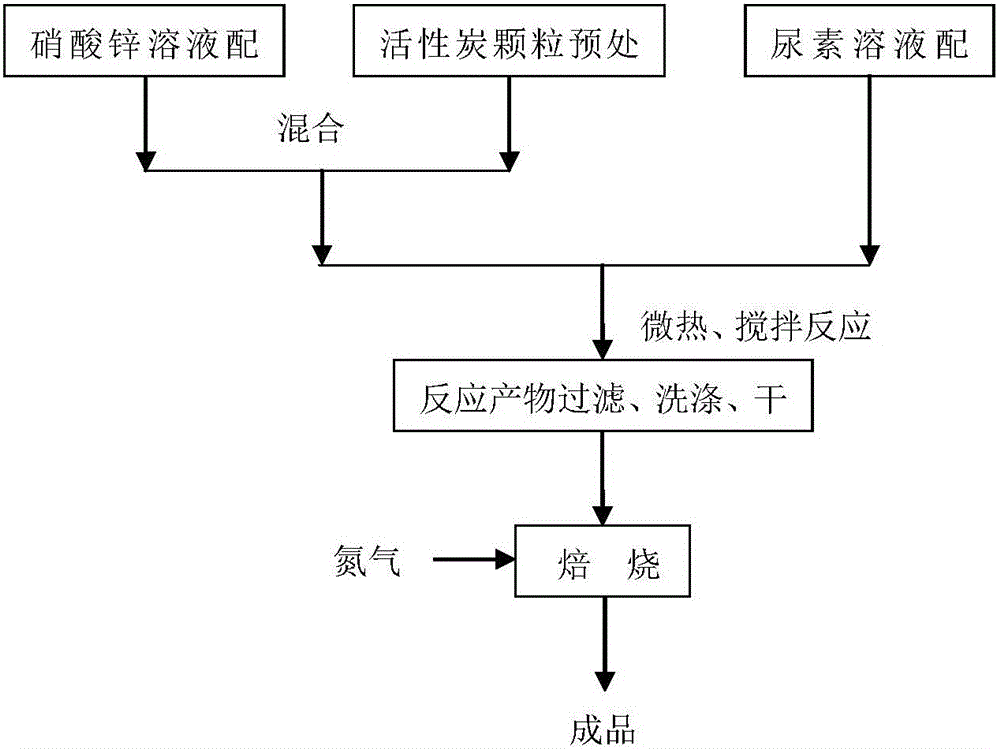Activated carbon-loaded nano-zinc oxide ozonation catalyst and preparation and use thereof
A nano-zinc oxide, ozone oxidation technology, applied in metal/metal oxide/metal hydroxide catalysts, physical/chemical process catalysts, chemical instruments and methods, etc., can solve problems such as catalyst loss, achieve efficient adsorption, good The effect of catalytic ozone oxidation
- Summary
- Abstract
- Description
- Claims
- Application Information
AI Technical Summary
Problems solved by technology
Method used
Image
Examples
Embodiment 1
[0018] Weigh 600g of zinc nitrate and prepare a saturated solution; weigh 350g of urea and dissolve it in 3150g of distilled water; select 2-3mm activated carbon particles and soak them in 10% sodium hydroxide solution for 12 hours, and wash them with distilled water until the pH value of the cleaning solution reaches Until it changes again, soak it in 10% nitric acid for 3 hours, wash it with distilled water, and dry it for later use. First add the dried pretreated activated carbon particles into the above-mentioned zinc nitrate solution, heat to 40°C, and then add the prepared urea solution while stirring for 8 hours. After the reaction, the product was filtered, washed and dried, and sent to a horse boiler, and roasted in a nitrogen atmosphere at 600°C for 3 hours to obtain a finished catalyst.
Embodiment 2
[0020] Weigh 300g of zinc nitrate and make a saturated solution; weigh 200g of urea and dissolve it in 800g of distilled water; pick 2-3mm activated carbon particles and soak them in 5% sodium hydroxide solution for 20 hours, and wash them with distilled water until the pH value of the cleaning solution reaches Until it changes again, soak it in 10% nitric acid for 4 hours, wash it with distilled water, and dry it for later use. First add the dried pretreated activated carbon particles into the above-mentioned zinc nitrate solution, heat to 50°C, and then add the prepared urea solution while stirring and reacting for 6 hours. After the reaction, the product was filtered, washed and dried, and sent to a horse boiling furnace, and roasted for 3 hours in a nitrogen atmosphere at 500°C to obtain a finished catalyst.
Embodiment 3
[0022] Weigh 900g of zinc nitrate and prepare a saturated solution; weigh 600g of urea and dissolve it in 2400g of distilled water; pick 2-3mm activated carbon particles and soak them in 10% sodium hydroxide solution for 16 hours, and wash them with distilled water until the pH value of the cleaning solution reaches Until it changes again, soak it in 8% nitric acid for 5 hours, wash it with distilled water, and dry it for later use. First add the dried pretreated activated carbon particles into the above-mentioned zinc nitrate solution, heat to 40°C, and then add the prepared urea solution while stirring for 8 hours. After the reaction, the product was filtered, washed and dried, and sent to a horse boiler, and roasted for 4 hours in a nitrogen atmosphere at 600°C to obtain a finished catalyst.
PUM
| Property | Measurement | Unit |
|---|---|---|
| diameter | aaaaa | aaaaa |
Abstract
Description
Claims
Application Information
 Login to View More
Login to View More - R&D
- Intellectual Property
- Life Sciences
- Materials
- Tech Scout
- Unparalleled Data Quality
- Higher Quality Content
- 60% Fewer Hallucinations
Browse by: Latest US Patents, China's latest patents, Technical Efficacy Thesaurus, Application Domain, Technology Topic, Popular Technical Reports.
© 2025 PatSnap. All rights reserved.Legal|Privacy policy|Modern Slavery Act Transparency Statement|Sitemap|About US| Contact US: help@patsnap.com

